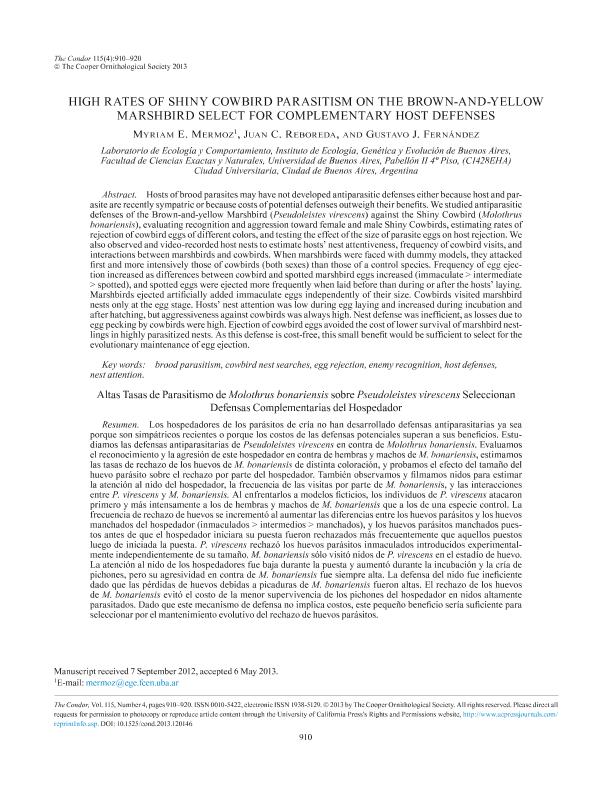Artículo
Hosts of brood parasites may have not developed antiparasitic defenses either because host and parasite are recently sympatric or because costs of potential defenses outweigh their benefits. We studied antiparasitic defenses of the Brown-and-yellow Marshbird (Pseudoleistes virescens) against the Shiny Cowbird (Molothrus bonariensis), evaluating recognition and aggression toward female and male Shiny Cowbirds, estimating rates of rejection of cowbird eggs of different colors, and testing the effect of the size of parasite eggs on host rejection. We also observed and video-recorded host nests to estimate hosts’ nest attentiveness, frequency of cowbird visits, and interactions between marshbirds and cowbirds. When marshbirds were faced with dummy models, they attacked first and more intensively those of cowbirds (both sexes) than those of a control species. Frequency of egg ejection increased as differences between cowbird and spotted marshbird eggs increased (immaculate > intermediate > spotted), and spotted eggs were ejected more frequently when laid before than during or after the hosts’ laying. Marshbirds ejected artificially added immaculate eggs independently of their size. Cowbirds visited marshbird nests only at the egg stage. Hosts’ nest attention was low during egg laying and increased during incubation and after hatching, but aggressiveness against cowbirds was always high. Nest defense was inefficient, as losses due to egg pecking by cowbirds were high. Ejection of cowbird eggs avoided the cost of lower survival of marshbird nestlings in highly parasitized nests. As this defense is cost-free, this small benefit would be sufficient to select for the evolutionary maintenance of egg ejection. Los hospedadores de los parásitos de cría no han desarrollado defensas antiparasitarias ya sea porque son simpátricos recientes o porque los costos de las defensas potenciales superan a sus beneficios. Estudiamos las defensas antiparasitarias de Pseudoleistes virescens en contra de Molothrus bonariensis. Evaluamos el reconocimiento y la agresión de este hospedador en contra de hembras y machos de M. bonariensis, estimamos las tasas de rechazo de los huevos de M. bonariensis de distinta coloración, y probamos el efecto del tamaño del huevo parásito sobre el rechazo por parte del hospedador. También observamos y filmamos nidos para estimar la atención al nido del hospedador, la frecuencia de las visitas por parte de M. bonariensis, y las interacciones entre P. virescens y M. bonariensis. Al enfrentarlos a modelos ficticios, los individuos de P. virescens atacaron primero y más intensamente a los de hembras y machos de M. bonariensis que a los de una especie control. La frecuencia de rechazo de huevos se incrementó al aumentar las diferencias entre los huevos parásitos y los huevos manchados del hospedador (inmaculados > intermedios > manchados), y los huevos parásitos manchados puestos antes de que el hospedador iniciara su puesta fueron rechazados más frecuentemente que aquellos puestos luego de iniciada la puesta. P. virescens rechazó los huevos parásitos inmaculados introducidos experimentalmente independientemente de su tamaño. M. bonariensis sólo visitó nidos de P. virescens en el estadío de huevo. La atención al nido de los hospedadores fue baja durante la puesta y aumentó durante la incubación y la cría de pichones, pero su agresividad en contra de M. bonariensis fue siempre alta. La defensa del nido fue ineficiente dado que las pérdidas de huevos debidas a picaduras de M. bonariensis fueron altas. El rechazo de los huevos de M. bonariensis evitó el costo de la menor supervivencia de los pichones del hospedador en nidos altamente parasitados. Dado que este mecanismo de defensa no implica costos, este pequeño beneficio sería suficiente para seleccionar por el mantenimiento evolutivo del rechazo de huevos parásitos.
High Rates of Shiny Cowbird Parasitism on the Brown-and-yellow Marshbird Select for Complementary Host Defenses
Título:
Altas Tasas de Parasitismo de Molothrus bonariensis sobre Pseudoleistes virescens Seleccionan Defensas Complementarias del Hospedador
Fecha de publicación:
11/2013
Editorial:
Cooper Ornithological Society
Revista:
The Condor
ISSN:
0010-5422
e-ISSN:
1938-5129
Idioma:
Inglés
Tipo de recurso:
Artículo publicado
Clasificación temática:
Resumen
Palabras clave:
Brood Parasitism
,
Cowbird Nest Searches
,
Egg Rejection
,
Enemy Recognition
Archivos asociados
Licencia
Identificadores
Colecciones
Articulos(IEGEBA)
Articulos de INSTITUTO DE ECOLOGIA, GENETICA Y EVOLUCION DE BS. AS
Articulos de INSTITUTO DE ECOLOGIA, GENETICA Y EVOLUCION DE BS. AS
Citación
Mermoz, Myriam Emilia; Reboreda, Juan Carlos; Fernandez, Gustavo Javier; High Rates of Shiny Cowbird Parasitism on the Brown-and-yellow Marshbird Select for Complementary Host Defenses; Cooper Ornithological Society; The Condor; 115; 4; 11-2013; 910-920
Compartir
Altmétricas




